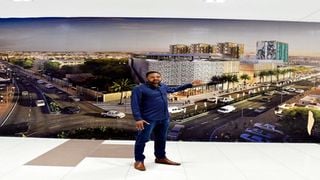
Abdi Dalmar from the Business Bay Square Mall management office points at an artist's impression of the mall in Eastleigh on General Waruingi Road on October 25, 2023.
| Francis Nderitu | Nation Media GroupNairobi
Premium
Eastleigh rising: How Nairobi got its mojo back
What you need to know:
- That multiculturalism comes to life in the evening, when the sun casts an enchanting blanket of orange over the neighbourhood.
- Standing on the rooftop of the newest mall here, one cannot fail to notice how everything seems to blend in with everything else.
Standing on the rooftop of the newest mall in this once-forsaken land, observing, analysing, admiring and soaking it all in, one cannot fail to notice how everything has changed, and how everything now seems to blend in with everything else. The crowds, the spanking new apartment blocks, the traffic, the riot of multicoloured LEDs, and the silhouetted frames of men, women and children all appear to be waltzing in perfect harmony. As if, somehow, the ebb and flow of life has found a new rhythm so profound, so strong that every little thing here has to be in sync. Yes, the new Eastleigh is a community in poetic motion
“Welcome to Dubai!” Dalmar Abdi smiles his greetings as we step into the second-floor lift lobby of Business Bay Square, the spanking new mall in the Eastleigh district of Nairobi. He says it jokingly, as if to lure us into discovering the Emirati-esque qualities of this new property, but minutes later he repeats it, and then it occurs to me that Dalmar is not joking about the new social fortunes and commercial postures of this part of the city, but actually means it.
I have been a bit cagey about going to Eastleigh. I have never liked the place as it has always been this chaotic maze of unplanned, ugly buildings, narrow streets, choc-a-bloc traffic, and crime straight from a James Hadley Chase novel. The last time I was here about 10 years ago I bought two shirts and two pairs of trousers. And all of them shrunk into ill-fitting pieces of textile junk after the second wash. That was it for me. Eastleigh was never going to cut it for me. I could put up with the traffic and the occasional pick-pocket, but if I couldn’t button the shirts or zip up the trousers, what was the point?
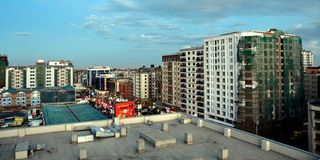
High-rise commercial and residential buildings in Eastleigh as seen from the rooftop of the Business Bay Square Shopping Mall on October 25, 2023.
“That was the Eastleigh of 10 years ago,” Dalmar says, admitting the chaos of the past but also pointing us to the new optimism of this famous Nairobi suburb. Photographer Francis Nderitu, NTV videographer Wambui Kurema and I have come here to explore, discover and conduct a journalistic survey of the amazing transformation of this place in the last decade. Most crucially, we have also come here to learn, to be one with the community, and to delve into the delicate interconnectedness of everything that makes this new Eastleigh tick.
There is a celebratory mood in the air. One that is filled with the drawl of rush-hour traffic, the thuds of a thousand footsteps on concrete and tarmac, and the din of conversation swallowed by the jarring clatter of hundreds of construction sites. New residential buildings are coming up everywhere you turn. They are the modern replacements of the old structures that have stood here for decades, and which gave Eastleigh its characteristic dark-brown, wind-swept hue from above.
The roads have been tarmacked. Some dualled too, including the famous First Avenue, for years one of the worst places to drive in, in Nairobi. The mountains of garbage that stank to the high heavens for decades have been cleared from Third, Fourth and Fifth streets, the pavements paved, and the road leading to Eastleigh Boys High School, previously a potholed mess, is now a neat driveway, complete with lush greenery that divides the avenue. And it has streetlights. And the streetlights work.
Dalmar steps back to let us absorb the changes. He is grinning like a Cheshire cat because he can see we are impressed by this remarkable rebirth. Before he came to help market the new Eastleigh, he was working for the Chinese technology giant Huawei. He has travelled the world and has been exposed to the best practices in urban planning and management.
As I watch him talk, it occurs to me that he represents the new face of Eastleigh; one that is comprised of very well-educated young men and women who are very articulate, have the right intellectual heft, and are well-travelled. This new crowd is reshaping the narrative about this hub and is working hard to change the perception that this is a distinctly Somali enclave by giving it a soft brush of multiculturalism and a bit of social permissiveness.
That multiculturalism comes to life in the evening, when the sun casts an enchanting blanket of orange over the neighbourhood. Looking westwards, the Nairobi skyline is a perfect silhouette straight from a Bonfire Adventures holiday brochure. Below us and around us, the helter-skelter of the city is slowly transforming into something more relaxed as the crowds melt into the backstreets and alleyways.
A riot of LED lights erupts in the far distance, signalling the start of another form of life here once the sun dips. A chorus of muezzins makes the calls for Isha, the nightfall prayer for Muslims, from what sounds like a thousand public address systems mounted on minarets that rise to the sky from whichever corner of this settlement your eyes can reach.
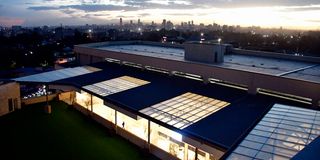
The skyline of Nairobi City's Central Business District as seen from the rooftop of Business Bay Square (BBS) Mall in Eastleigh on October 25, 2023.
Standing on the rooftop of the newest mall here, observing, analysing, admiring and soaking it all in, one cannot fail to notice how everything seems to blend in with everything else. The crowds, the apartment blocks, the traffic, the riot of multicoloured LEDs, and the silhouetted frames of men, women and children all appear to be waltzing in perfect harmony. As if, somehow, the ebb and flow of life has found a rhythm so profound, so strong that every atom and molecule here has to be in sync.
Dalmar calls it “the flow of the community”, but his description does scant justice to what is unfolding before our eyes. It is true that communities learn to live with each other, to tolerate each other and to roll with the rough and tough of times. In popular culture, they are depicted in movies and literature as these robotisised bands whose lives revolve around habit rather than rhythm, and whose common existence, without that habit, becomes a miserable collection of empty nothings.
But the scenes here do not appear to fit that description. Everyone seems to effortlessly belong. This is a community in poetic motion. Or, as the American author Peter Block puts it in the book Community – aptly subtitled ‘The Structure of Belonging’ – these people seem to have carved out a life from a hitherto isolated suburb and put their skills, wisdom, capacities and entrepreneurial energy to good use. The thousands milling around Eastleigh this evening do not need anything else other than that feeling of relatedness to the wider community, and they are wearing it up their sleeves with pride and joy.
Moments later, we are sitting at the Grand Café and Indian Cuisine restaurant inside Business Bay Square, talking to community leaders and observing the evening footfall into the shopping complex, when the power of this relatedness becomes apparent.

Eastleigh Business District Association (EBDA) Organising Secretary Omar Yussu Abdi.
Omar Yussu Abdi, the organising secretary of the Eastleigh Business District Association, has spent the first few minutes explaining the economic revolution of this suburb, extolling the virtues of nationhood, patriotism and belonging. To him, and indeed to the many others here, to belong is to be related to the hushed, common existence of Eastleigh, to earn membership and acceptance in this bubbly community, and to bask in the experience of ‘being home’ in the broadest sense of that expression.
But, to Abdi, to belong here is actually bigger than that. To belong to Eastleigh is to own it. To act as a creator and co-owner of this society. To seek a wider and deeper sense of emotional and communal ownership. And, as his namesake Dalmar had earlier put it, to foster among the co-equals here a sense of ownership and accountability, both in their relationships and in the billions of shillings in revenue that they control annually.
It wasn’t easy to get here, Abdi admits. The profile of this place was a mish-mash of everything that could go wrong in an urban settlement. Planning failures made it a sorry picture of bedlam; the poster child of metropolitan unruliness. Nothing seemed to work here and the commerce was suspected to be supported by a cagey tax evasion syndicate that smuggled clothes, electronics and foodstuff from questionable suppliers abroad.
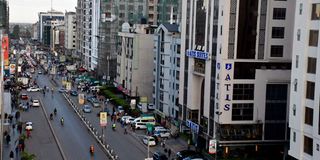
New high-rise buildings along General Waruingi Street in Eastleigh on October 25, 2023.
Then, to make matters worse, the planning and financing of a series of terror attacks in the early-to-late 2010s was traced to people who had passed or lived here, and Eastleigh, the doggone, tax-cheating, cheap goods haven faced condemnation and ridicule from the rest of Kenya. It became an unwanted child whose reputation appeared irredeemably scarred.
To turn things around, this community had to be deliberate and ruthless, says Abdi. It established a leadership council that co-opted local political leadership and the security agencies. A robust community policing project patrolled every corner and crevice of this suburb, flushing out criminals and handing them over to the police. Security became everyone’s agenda. And image, too.
“Now this is one of the most secure neighbourhoods in this city,” says Abdi. “It is one of the few places I know where you can walk casually at midnight while making a call and no one will bother you. Some areas of Kilimani and Kileleshwa do not even enjoy that kind of security.”
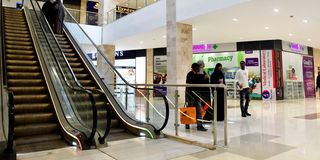
Shoppers at Business Bay Square Mall in Eastleigh on October 25, 2023.
Property prices here now also rival those of the more affluent Kilimani and Kileleshwa, with a 50X100 piece of land on First Avenue going for upwards of Sh300 million, says Abdi. These properties are being snapped up by a club of super-rich investors who are pulling down old buildings and putting up high-end highrise apartments. The result is a remarkable reconstruction of Eastleigh and an expansion of its tentacles beyond its traditional boundaries. This expansion has swallowed up the entire Pangani neighbourhood, parts of California estate towards Majengo, and whole sections of the general area known as Juja Road.
Abdi says this is deliberate.
“We have already expanded these property investments into Parklands, Kilimani and Kileleshwa,” he points out, adding, when asked where next he sees these tentacles expanding, that Kiambu and Kitengela are promising targets for exploration.
To understand the long journey Dalmar and Abdi have walked, one needs to go back to the formative years of Eastleigh in the early 20th Century. Initially planned as a residential area for colonial administrators and other European settlers, the area was characterised by large, well-designed houses with lush gardens and tree-lined streets. However, as Nairobi expanded and the demand for housing increased, Eastleigh saw its first wave of immigrants in the 1920s, when Indian and Arab traders began settling there.
In the 1940s, the Indian and Arab communities were joined by Somali immigrants. The Somali community, in particular, grew steadily and made a significant impact on the neighbourhood, many of them drawn here by the district’s proximity to the Eastleigh Airport. During the 1930s, Wilson Airport was the only aerodrome in Nairobi and became a stopping place on a new air route operated by Imperial Airways, which later became British Airways, across Africa. But World War II brought with it the need for a second, bigger airport east of the city centre on vacant land at Eastleigh. The airport was built initially as a colonial air force outpost named RAF Eastleigh but was soon shared by civilian airliners. Today it is operated by the military as Moi Air Base.
Eastleigh’s transformation began to accelerate soon after independence, when the Jomo Kenyatta government started implementing a policy of Africanisation that led to the exodus of many non-African residents from the neighbourhood. The vacant properties were quickly snapped up by new waves of largely local and East African investors, and by the early 1980s Eastleigh had rapidly evolved into a thriving and diverse commercial hub.
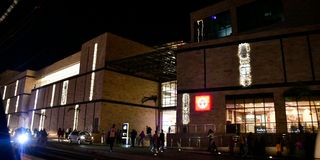
Business Bay Square (BBS) Mall in Eastleigh, Nairobi, on October 25, 2023.
Today, Eastleigh’s commercial success is the product of the entrepreneurial spirit of its residents. Known for decades for its bustling markets, including the famous Garissa Lodge, this Nairobi suburb quickly earned the nickname “Little Mogadishu” due to its large Somali population and its cultural and economic influence. But rapid population growth in the 1990s led to a series of crises, including congestion, inadequate infrastructure, and a lack of proper sanitation. Security concerns, including occasional outbreaks of violence and crime, also became a focus for authorities.
It is important, perhaps, to note that the nickname “Little Mogadishu” is today not merely a reflection of the Somali community's presence, but also an acknowledgment of the diverse and multicultural nature of this suburb. The neighbourhood is today home to various other East African communities, each contributing to its vibrant and dynamic character. Eastleigh’s identity as “Little Mogadishu”, therefore, is a celebration of cultural diversity and a testament to the coexistence of different ethnic groups within the neighbourhood.
That coexistence has spawned a new ethos of entreprise. Some reports indicate that this two-square-kilometre zone produces more revenue per day than some entire towns in the country. Indeed, this spirit of entrepreneurship is captured well by Prof Neil Carrier, Associate Professor in Social Anthropology, Department of Anthropology and Archaeology at the University of Bristol in the United Kingdom, in his 2017 book, Little Mogadishu: Eastleigh, Nairobi's Global Somali Hub.
In the book, Prof Carrier examines how the local retail business model has managed to keep thriving and, as a result, generated a complex commercial ecology spanning the hawkers clogging the sidewalks outside the malls to a booming hospitality and services sector and formal enterprises, including Islamic banks and money transfer companies linking diaspora capital to investment opportunities in Kenya and other areas of the Horn.
A 2017 review of Prof Carrier’s book by The EastAfrican noted that he had untangled “the different threads contributing to Eastleigh’s economic exceptionalism, recording how they came together out of a conjunction of colonialism, migration, civil war, globalisation, and transnational ethnic networks” to live and thrive here. Prof Carrier also examines the transition of Eastleigh from what began as a patchwork of micro-enterprises and informal sector activities to a home for formal sector enterprises that became the third largest tax revenue generating area of Nairobi.
But, at the same time, Prof Carrier, just like Abdi and Dalmar, uses the book to set the record straight on how Somalis and other members of the Muslim community became the primary victims of state human rights abuses and reprisals based on an awkward policy of collective responsibility at the height of the war or terrorism and transnational crime.
Eastleigh, he notes, became the scapegoat for the series of terrorist attacks, even though the Muslim Youth Centre in the nearby Majengo settlement was identified as the main Al-Shabaab recruiting node under the influence a charismatic community activist named Iman. Abdi, the organising secretary of the Eastleigh Business District Association, says this suburb has turned a new leaf and has shaken off that tag.
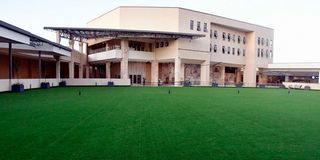
A children's play area at Business Bay Square (BBS) Mall in Eastleigh, Nairobi on October 25, 2023.
And indeed it has. Eastleigh is now positioning itself as a modern business hub. It’s biggest mall, the new Business Bay Square, is scheduled to be officially opened in the coming months but business is already thriving here. Boasting parking for 2,000 cars and one of the largest shopping acreage in the country BBS, as Dalmar abbreviates it, is being designed a mixed-use community that will, once complete, also host a five-star hotel and serviced apartments. Its anchor tenant is the Carrefour supermarket chain but Dalmar says it offers “everything that Eastleigh is known for.”
Abdi, on the other hand, says the business community has embarked on an initiative to be tax-compliant. The leadership organises regular clinics with business people during which it trains them on taxation, book-keeping and licensing procedures. This, Abdi says, is aimed at shedding off that “smugglers” tag that has hung in the air here like a stubborn virus.
As we sit and talk, and as we drive around this neighbourhood in the evening, it is clear that decades of disorganisation are slowly giving way to a new dream. This vibrant community might not have a single visible thread tying it together, but its aspirations and concepts of socialisation, mutualism and collective existence have brought it here, and it is not looking back.
And, who knows? This could indeed become our little Dubai!





